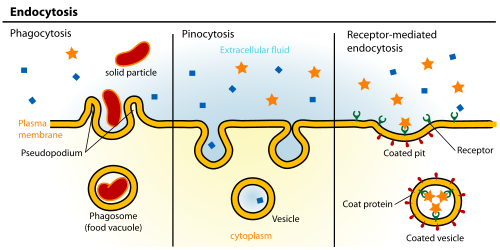Cell membrane
There is a cell membrane (cytoplasmic membrane, biomembrane) on the cellsurface . Biomembranes regulate the passage of substances from the environment to cells and vice versa.
Each membrane is made up of proteinand lipidmolecules , and to a lesser extent carbohydratesmolecules in the form of glycoproteins and glycolipids. The base is a lipid bilayer . Protein molecules are present on the surface of this layer (they are glycoproteins) and have primarily a protective function.
Protein types :
- integral proteins - are partially or completely immersed in the lipid layer; they are very difficult to separate from the membrane;
- peripheral proteins - are on the surface of the lipid layer; they are not tightly bound to the membrane.
Proteins are only in some parts of the membrane. The membranes have a semi-liquid character and the protein and lipid molecules are in constant motion ( liquid mosaic ).
If the surface of some organelles is formed by membranes, they are called membrane organelles . If there is a local accumulation of membranes, these structures are referred to as layered (lamellar).
The plasma membrane is essential for cell life. It limits the cytoplasmto the environment, regulates the transport of substances between the cell and the environment. Cell-cell contacts occur through the plasma membrane.
Contact types :
- by touching surface membranes ;
- using desmosomes - fibers that penetrate from one cell to another.
Many receptors are located in the plasma membrane that respond to environmental chemical signals and regulate cell activity. Receptorsalso differentiate between own and foreign cells, receive substances from the environment and play an important role in cell irritation. The plasma membrane is semipermeable - it is freely permeable only for some substances. Other substances are transported mechanisms, which we refer to as the transport of substances.
Methods of substance transfer :
- Diffusion- free flow of substances according to the concentration gradient.
- Passive transport - transport is performed using the substrate to which the substance binds. The transfer takes place according to the concentration gradient.
- Active transport- transfer takes place by binding to the substrate and requires energy. It is also possible against a concentration gradient.
The cell can receive and release such substances for which active transport is not possible (size, chemical properties).
Transmission methods :
- Exocytosis- the secretion in the closed bladder in the cell approaches the plasma membrane, fuses with it and releases the contents to the cell environment.
- Endocytosisand pinocytosis- begins as the plasma membrane enters the cell, then the edges close and the bladder (with a closed particle around the cell) splits off. The bladder wall in the cell dissolves and the contents of the bladder mix with the cytoplasm.
- Phagocytosis- the cell sends protrusions to the particle, so-called pseudopodia , by which it surrounds and absorbs the particle.
Links[edit | edit source]
Source[edit | edit source]
- ŠTEFÁNEK, Jiří. Medicine, diseases, study at the 1st Faculty of Medicine, Charles University [online]. [feeling. January 29, 2010]. < http://www.stefajir.cz >.


